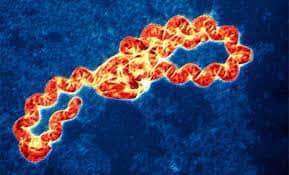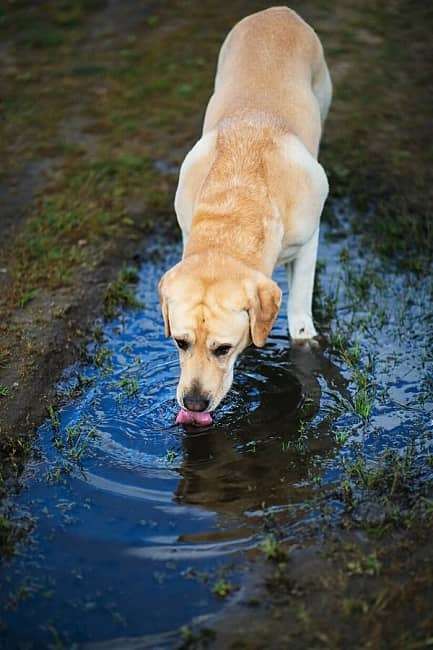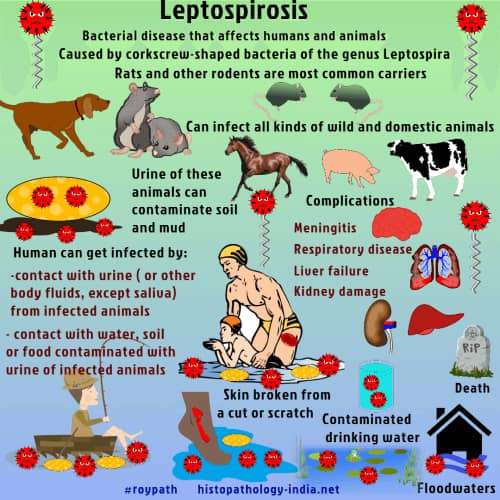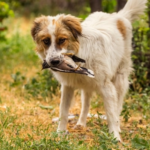About the Organism
Leptospira organisms are spiral-shaped bacteria in a group called spirochetes. There are several species of leptospires, but the ones that cause disease have been grouped into one particular species called Leptospira interrogans sensu lato.

Species have been classified into sub-species called serovars. Over 250 serovars have been found with 10 being important for pets. Dog vaccination is against the four most common serovars.
Different serovars or strains produce different types of disease and are in different geographical areas. The serovars commonly found in dog infections are below:
Canicola – This serovar is the most common in Mexico. It produces primarily kidney disease. This serovar can also be an issue in dogs living near the Mexican border.
Pomona – This serovar is associated with livestock and tends to produce severe disease in both the kidney and liver.
Grippotyphosa – In a survey of over 1,200 healthy dogs in Michigan, 24% of them tested as exposed to Leptospira and the Grippotyphosa serovar was the most common.
Icterohaemorrhagiae -This serovar is mostly associated with exposure to rats and rat urine in standing water. It tends to attack the liver. Please note that in some areas over 90% of rats tested were exposed.
Leptospires live best in warm, slow-moving water such as after heavy rains or flooding. It is excreted in the urine of infected mammals. After the water clears, they contaminate soil for many months. Wildlife are common carriers of infection.
A survey in Connecticut found 36% of racoons had been exposed while a survey in Illinois found 48% of raccoons had been. Another survey found 50% of rats had been exposed. Classically, infection of dogs and humans stems from the urine of infected animals getting into standing pools of water.
Leptospirosis is a common human disease in tropical areas, especially where rice is farmed and rats infest the paddies. It is believed that infected rats are contributing to the rising incidence of canine leptospirosis in urban areas. In fact, the disease is on the rise throughout the US.
It’s not just dogs that spend times outdoors that are affected. Dogs that are kept primarily inside are still exposed to rats and rat urine. In 2021 there was an outbreak in a Los Angeles started in boarding facility where dogs were frequently exposed to the urine of other dogs.
Canine Infection

Dogs become infected by leptospires when irritated or cut skin comes into contact with infected urine. Alternatively, bite wounds, exposure to reproductive secretions, and even eating infected tissues can transmit this infection.
The organisms quickly spread through the bloodstream, leading first to inflammation and can also lead to fever, bleeding disorders, abnormal bruising and tissue edema after 7 days. By 2 weeks post-infection, the leptospires have set up shop in the kidneys and/or liver where they continue to result in inflammation, pain and potentially total kidney failure with their inability to produce urine and / or liver disease.
If the organism migrates to the lungs, dogs can develop pulmonary hemorrhage (bleeding of the lungs). The lung bleeding results is associated with a 70% mortality rate and bodes especially poorly.
If the dog is able to keep the acute illness at bay, a chronic form may emerge. There can be a more chronic kidney insufficiency and/or liver inflammation (hepatitis).
Furthermore, the long-term immune stimulation can lead to a deep eye inflammation called uveitis that can cause the eyes to look cloudy or even change color. If the disease is treated at this late stage, it may not be possible to reverse the long-term damage that has already set in.
The Different Symptoms of Leptospirosis
Leptospirosis can look different depending which serovar and how it migrates through an individual’s system: fever with bruising, muscle soreness and bleeding; fever with different degrees of kidney failure; liver disease by itself or with kidney disease; chronic hepatitis; and eye inflammation etc.
Another way to look at leptospirosis is to look at the time frame of the illness and how quickly or slowly it came on.
Stages:
Peracute Disease: sudden onset. These are usually younger dogs with an overwhelming exposure. The large amount of leptospire toxin causes rapid death before the kidney or liver disease even happens.
Acute Disease and Subacute Disease: This is the classic form described above: fever with bruising and bleeding, general muscle pain, painful belly from the kidney and/or liver disease. There may be jaundice and inflammation in the eyes that makes them look cloudy.
Chronic Disease: Recurring fevers, chronic hepatitis, chronic kidney disease, uveitis, poor appetite, weight loss.
Younger dogs (less than 1 year of age) tend to get the most severe forms of leptospirosis.
87-100% of infected dogs will have some degree of kidney issues, which means kidney values will be elevated on routine blood testing.
Excessive water consumption is frequently seen at home as the kidneys fail to do their job of conserving water.
How to Test for Leptospirosis:
PCR Testing
PCR testing is used to detect leptospire DNA. A blood sample is best in the first 10 days after infection, but after that a urine sample is more likely to be positive. It may be prudent to submit both blood and urine samples.
Past vaccination will not interfere with this test, although antibiotic exposure certainly will, and results can be back in a day or so. PCR testing will not determine which serovar is present.
MAT Testing (the Traditional Antibody Test)
The Microscopic Agglutination Test or MAT test is still considered the test of choice though it has some disadvantages. It measures antibody levels against different leptospirosis serovars with the idea being that the one with the highest level is most likely to be the serovar causing the disease.
Antibody levels are expressed as titers, which are ratios reflecting how much dilution is needed before it is too dilute to detect antibodies. For example, a titer of 1:32 means a serum diluted out 32 times still had detectable antibody.
A titer of 1:32 may sound pretty high but it is actually pretty low; an MAT titer must be at least 1:800 to be considered positive. If the serovar under consideration has an associated vaccine, a titer more like 1:3200 is considered positive.
To really obtain high confidence in the diagnosis of Leptospirosis, a second titer is submitted 2-4 weeks later showing at least a four-fold increase in antibody production. Treatment with antibiotics should not interfere with the validity of the second (or “convalescent”) titer level.
There are two problems with this testing:
- No one wants to wait 2-4 weeks to confirm the diagnosis especially with a disease contagious to humans. PCR testing gets results much faster.
- Vaccination interferes with results (remember the entire goal of vaccination is to generate an antibody titer). Vaccination history can make interpretation difficult.
In-House Test Kits and other General Antibody ELISA Tests
Recently in-house screening tests have become available so that a result can be obtained in 20 minutes or so. These tests screen for antibodies against Leptospira organisms. They are either positive or negative. They will not tell you which serovar is involved nor tell you how high the titer is.
They will not distinguish antibodies from vaccination versus those from true infection. Clearly a positive test needs to be followed by another test. A negative test, however, is very helpful (see below).
Which Tests to Use?
A good approach is to begin with is a general antibody test combined with urine and blood PCR testing. If any PCR test detects Leptospira DNA either in blood or in urine, infection is confirmed. An MAT test will determine which serovar is afoot and the antibody level can be tracked to be sure treatment is working.
If the PCR tests are negative (meaning Leptospira DNA was not detected) but a general antibody test is positive, the MAT test will determine if the antibodies are related to prior vaccination or active infection.
If PCR tests are negative (Leptospira DNA not found) and no antibodies are found either, then it should be safe to cross leptospirosis off the list of possible diagnoses.
Treatment
Fortunately, Leptospira interrogans sensu lato is sensitive to doxycycline, a readily available antibiotic. Leptospires are cleared from the blood within 24 hours of starting it but it takes about a week for them to clear from the urine, so it is important for you to wear gloves, goggles, etc. and be conscious of contamination.
Infected animals should be isolated from other animals at least until their antibiotic course is complete and probably for a couple of weeks after. Check with your veterinarian for instructions.
Intravenous fluids are crucial to support blood flow through the damaged kidneys so that recovery is possible. Any areas at home that have been contaminated with urine should be disinfected with an iodine-based product and you should wear gloves while cleaning any urine.
Prognosis is guarded depending on the extent of organ damage; with appropriate treatment 80-90% survival rates are reported.
This sounds wonderful but it is important to keep in mind factors that can interfere with this rosy outcome. While most leptospirosis-related kidney injury responds to fluid therapy as can be given by most animal hospitals, more severe cases can require dialysis, which has limited availability. As mentioned, lung involvement has poor surviviability. Infection with the Pomona serovar is associated with more severe disease.
A good two weeks of doxycycline is generally needed. If this antibiotic is not tolerated, amoxicillin may also work.
Previously infected dogs may become re-infected. Past infection does not confer future immunity.
Prevention
Vaccination against Leptospira interrogans sensu lato is only available for the serovars called Canicola, Grippotyphosa, Pomona and Icterohaemorragiae. As a result of long-standing use of this vaccine, it is hard to assess how important it is to vaccinate against leptospirosis.
As you might imagine, most recent outbreaks involve serovars for which vaccination does not exist, which suggests that the vaccine is working.
More and more veterinarians are starting to consider leptospirosis vaccination essential. The American Animal Hospital Association vaccine guidelines consider vaccination against leptospirosis to be optional but recommends that if you are going to vaccinate for leptospirosis, use a vaccine covering all four serovars.
Other important aspects of prevention include controlling rodents in the pet’s environment and removing standing water.
The Infection in Humans

The Centers for Disease Control and Prevention monitors leptospirosis cases in people, it seems that one third come from contact with infected dogs and one third come from contact with rats (usually through field work).
Recreational activities involving water and exposure to flood waters are also associated with human outbreaks. Other human risk factors include farm work, animal care work, camping, and sewer work. Remember, leptospires come from contaminated urine which, in turn, contaminates environmental water and soil.
The same symptoms occur in humans as would be seen in dogs.


